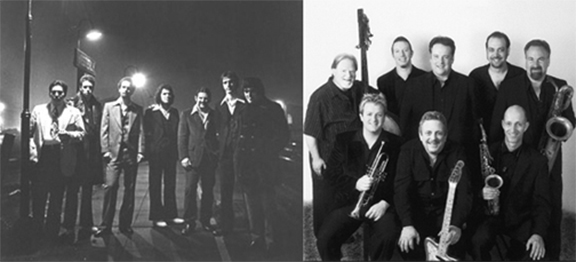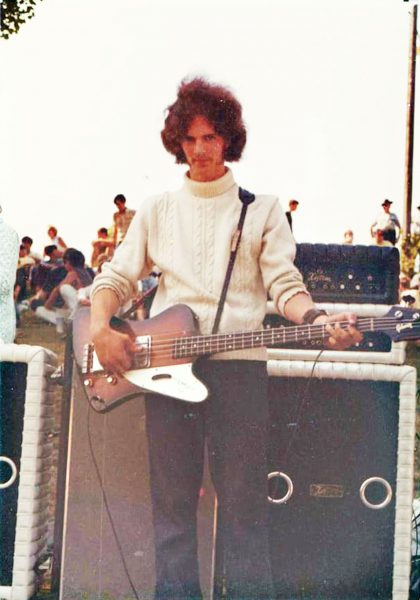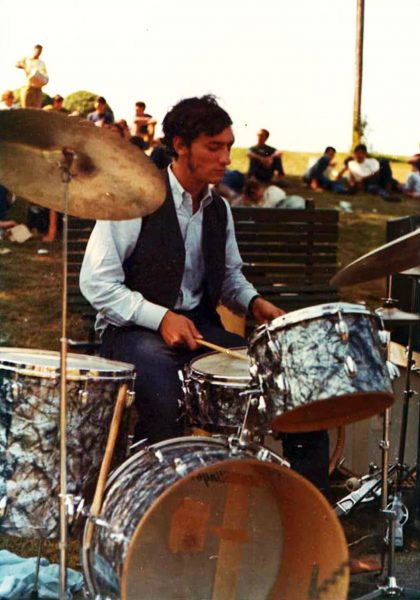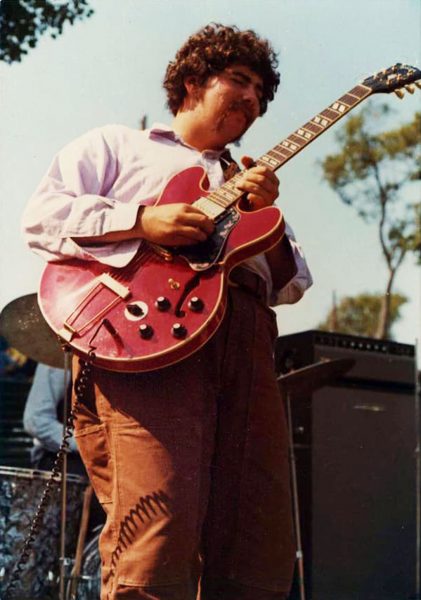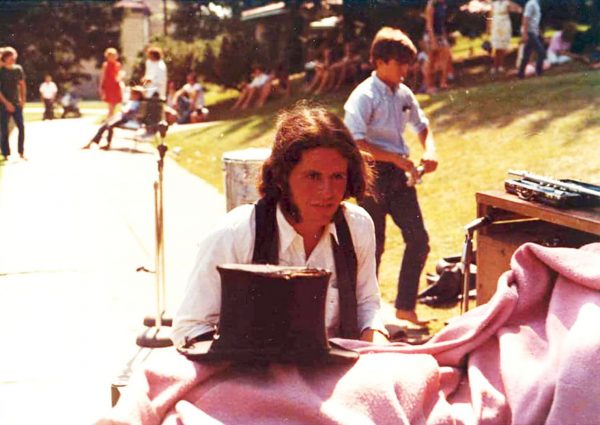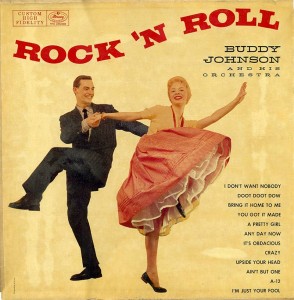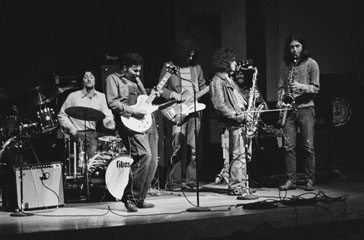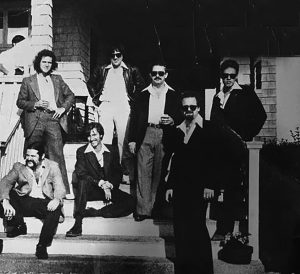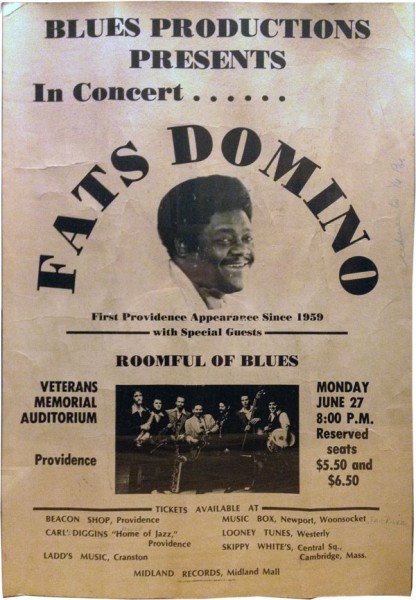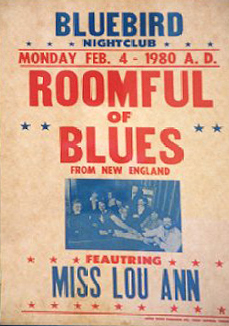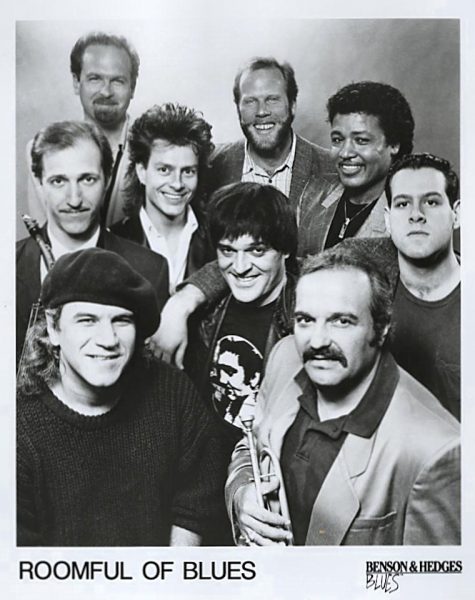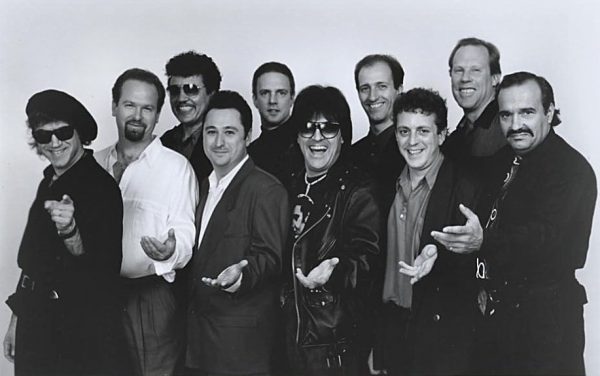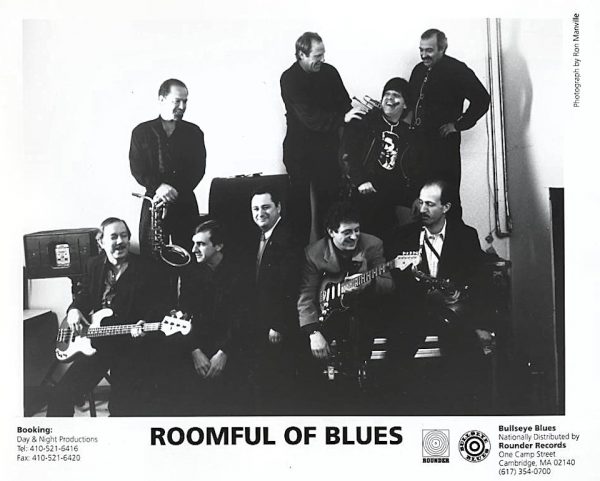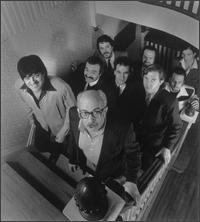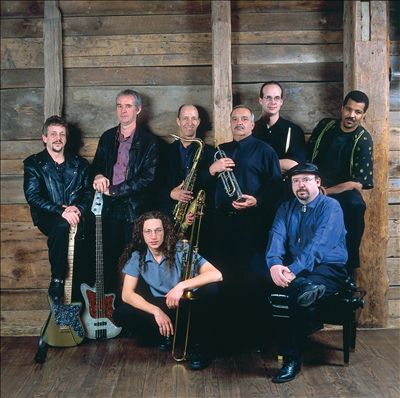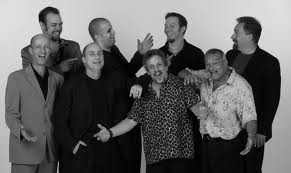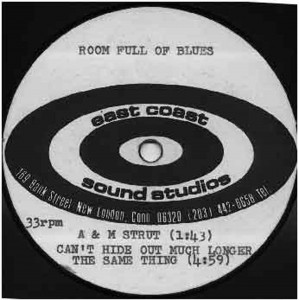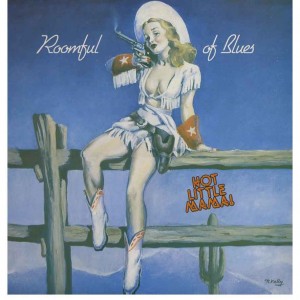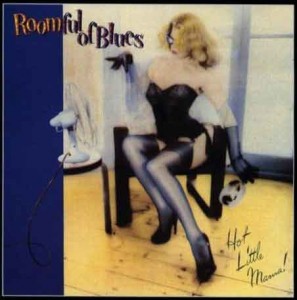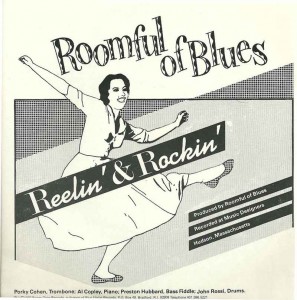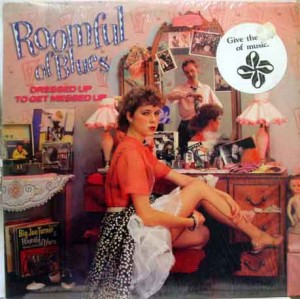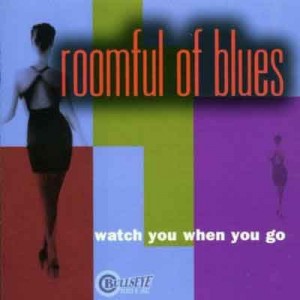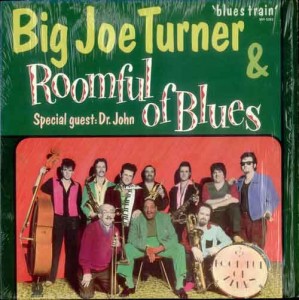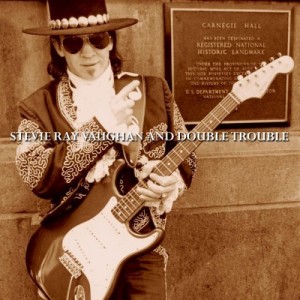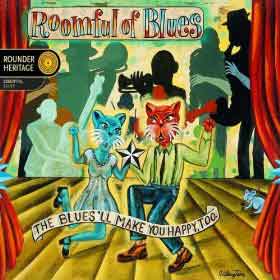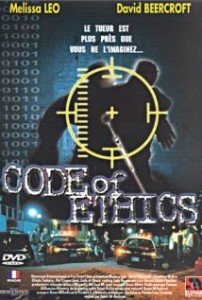Roomful of Blues
2012 INDUCTEE
Blues/R&B
THE BLUES WILL MAKE YOU HAPPY, TOO!
The Story Of
ROOMFUL OF BLUES
by Rick Bellaire
with much thanks to “Big” Al Pavlow and Marc Perry of the RIMHOF board; special thanks to Ronald Martinez, Al Copley, Greg Piccolo, Ron Levy, and Bobby and Fran Christina for taking the time to shed some light on the foggy areas; and deepest gratitude to Bob Bell, their manager of 23 years, without whose assistance and editing, this story could never have been written
FOREWORD
A Whole Room…Full of Blues
An Appreciation by Bob Angell
As presented at the first annual Rhode Island Music Hall Of Fame Induction Ceremony,
February, 2012
Bob Bell, Roomful’s longtime manager and self-confessed “evangelist” for the group told me on the telephone recently that in his 23 year run with the band, he always considered the following advice to be the best he ever gave them: “Listen, create …and play” and most of all “Do what you do best.”
In their long and storied career, Roomful of Blues have most certainly done that. From the earliest incarnation wherein Duke played a homemade electric guitar with a popsicle stick for a bridge, through the Room-Tone single, the Island LP and on through the Alligator years, the band has changed considerably. The line-up has undergone monumental overhauls over the decades, but the consistent factor is, and has always been, the actual music they produce on bandstands around the globe.
Few musical aggregations have been able to regularly produce a sound so immediately identifiable as Roomful of Blues. Their artistic vision has never faltered. When you walk into a ballroom or nightclub or concert hall or festival site and hear that stomping, horn-driven R&B, your first thought has to be “Ahh…Roomful’s in town.” It’s time to get your dance on. And there’s something very comforting about that.
Though clearly based in 1940s-era jump blues, the band has expanded that genre and stretched its boundaries without ever abandoning its extensive root system. As Bell says, they quite often “go back to the well and drink deeply” as they did with their fine recordings with icons like Cleanhead Vinson and Joe Turner. And they venture out again refreshed, reinvigorated and reborn in the blues.
Wherever they work, Roomful of Blues represents. They represent the earthy music they play; they represent the genre they work in; they represent the blues… and they represent all of us. They’re Rhode Island’s very own. And they make us all very proud.
THE ROOTS OF ROOMFUL 1967-1970
The long and winding road which leads to the Roomful Of Blues of today can be followed all the way back to 1967 when a group of southern Rhode Island teenagers with a shared passion for the blues formed a straight-ahead “Chicago” electric blues band to explore the music of their heroes.
Mike Robillard was born in Woonsocket, Rhode Island in the late 1940s and by the time he left high school, his reputation as one of the area’s finest guitarists had begun to spread throughout the state thanks primarily to the popularity of his teen scene band The Variations. He made one of his earliest connections to the southern Rhode Island scene when one lineup of The Variations briefly included a young singer who doubled on alto sax, Greg Piccolo of Westerly. After graduation, Mike spent some time on a hippie commune up in Maine after which he returned to Rhode Island and relocated to Westerly to take a job at the world famous Guild Guitar factory and met pianist Al Copley. Copley was something of a prodigy who had a special affinity for the boogie woogie stylings of Albert Ammons, Pete Johnson, Meade Lux Lewis and the other “lions” of the genre. By the time he was 15, he’d mastered the style and had begun incorporating the more contemporary interpretations of the blues as offered by the great Chicago players of the modern era such as Sunnyland Slim, Little Brother Montgomery and Otis Spann.
The two friends formed a band called Roomful Of Blues named after a line in a poem written by Al’s friend Randy Saunders. They began performing with other area blues enthusiasts whenever and wherever there was an opportunity. It was something of a revolving cast of characters at first with musicians coming and going as needed and as available. Among the players in this early phase were bass guitarists Ed Parnagoni and Larry Peduzzi; drummers Chuck Riggs, Fran Christina and Joe Ferraro; singer/harmonica player Tony Lamb; harmonica wizard Steve Nardella; Greg Piccolo from The Variations who had since taken up the harmonica; and multi-instrumentalist George Peterle on rhythm guitar and C-melody saxophone.
Early on, there was a desire to commit their efforts to tape and Mike and Al took a lineup featuring Riggs, Lamb, Peduzzi and Peterle into East Coast Sound recording studios in New London, Connecticut to cut a five-song demo. Recorded in late 1967 or early 1968, the demo which survives only as a few copies cut direct to fragile 10″ acetates is not only a great preview of the greatness with which these musicians would shine worldwide in later years, but is also the rarest recording in the Roomful catalogue.
The original players soon coalesced into a regular four-piece lineup of Robillard, Copley, Christina and Peduzzi and for a few months, they began to make a mark on the southern New England music scene.
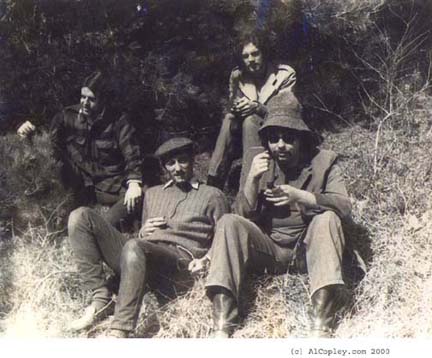
The earliest known photograph of Roomful of Blues, 1969: (left to right) Al Copley, Fran Christina, Larry Peduzzi, Mike Robillard (appears by kind permission of Al Copley, photo credit-Julie Speed)
One important, high-visibilty gig for the early lineup was their participation in the Moratorium To End The War in Vietnam demonstration which was held at Wilcox Park in Westerly, Rhode Island on October 15, 1969. On that day, gatherings were organized as teach-ins in cities across the country to disseminate information and hold planning sessions for the national demonstration which took place on November 15. Half a million people converged on D.C. for The Moratorium March On Washington which is believed to be the largest anti-war protest ever held in the United States. Below are historic photographs from the collection of Larry and Linda Peduzzi showing the members of Roomful performing for the participants.
But things got put on hold for a couple of years when opportunity came knocking in the form of an offer from another mover and shaker on the Rhode Island scene, Ken Lyon.
Lyon had been pursuing a career as a folk singer since the late 1950s and had three major label deals under his belt by 1967. Specializing in the acoustic folk/blues tradition, Lyon’s career along those lines had run its course and recognizing the inroads already achieved by young blues bands such as Paul Butterfield’s and the Seigel-Schwall unit, he decided to explore the electric side of the blues. With the backing of his New York producers, Mike Lewis and Stuart Weiner, he recruited Robillard and Nardella from the Westerly scene, and drummer Tommy DeQuattro, bass guitarist Al Lobello and pianist Mark Taber from the northern end of the state to form the original lineup of The Tombstone Blues Band. The group was one of the finest American blues bands in history, as anyone who ever heard them live could attest, but their major label release for Metromedia not only failed to capture the power of the band, but did nothing sales-wise. Although the label was willing to proceed with an album project, Lyon opted out of the deal and the original version of Tombstone was put to rest. (It was during this period that Robillard acquired his original nickname of “Honeybear” due to his wild Afro and beard.)
Copley was, by this time, playing regularly in other bands, most notably in partnership with Greg Piccolo in Groupe (later known as Greg & The Groupe) and was preparing to attend the Berklee School of Music, so was unavailable to reunite with Mike at the time. Robillard and Nardella hooked back up with Fran Christina who brought in guitarist Johnny Nicholas to form another now-legendary unit in Rhode Island lore, The Black Cat Blues Band. Black Cat was another astoundingly great outfit which achieved much success and notice on the southern New England scene, but failed to attract the attention of the record companies. (It was during this time that Robillard acquired his more refined and, now, world-famous nickname of “Duke.”) During Black Cat’s run, two things happened to Duke which would prove to be milestones in determining his musical path. He was introduced to urban-based, horn-driven R&B – “jump blues” – via the album “Rock ‘N Roll” by Buddy Johnson & His Orchestra, and he had the opportunity to see alto sax legend Eddie “Cleanhead” Vinson in person at the 1970 Ann Arbor Blues Festival in Michigan. He knew instinctively where his future lie. As soon as Black Cat had run its course, he knew what his next move would be. And it didn’t take long.
By late 1970, Nardella, Nicholas and Christina had decided to move out to Detroit to pursue their own vision and there recruited bassist Sarah Brown to form The Boogie Brothers Band. (All of these musicians loom large in the history of Rhode Island music and their careers will all be documented with in-depth entries here in the RIMHOF Archive in the future.) Duke wasted no time and was soon back in Westerly and back with Copley. The group recruited their first two horn players, their old pal Greg Piccolo, who had switched from alto to tenor, and Richard Lataille who doubled on alto and tenor. Next, they put together the rhythm section which would last for a long time consisting of Ed Parnagoni and one of the swingin’-est drummers on the Rhode Island scene, John Rossi who had been playing with an early lineup of The Hamilton-Bates Blue Flames.
They began experimenting with the new sound and by 1971, decided another sax was needed – this time, a baritone, to really flesh out the horn arrangements – and the group added Doug James.
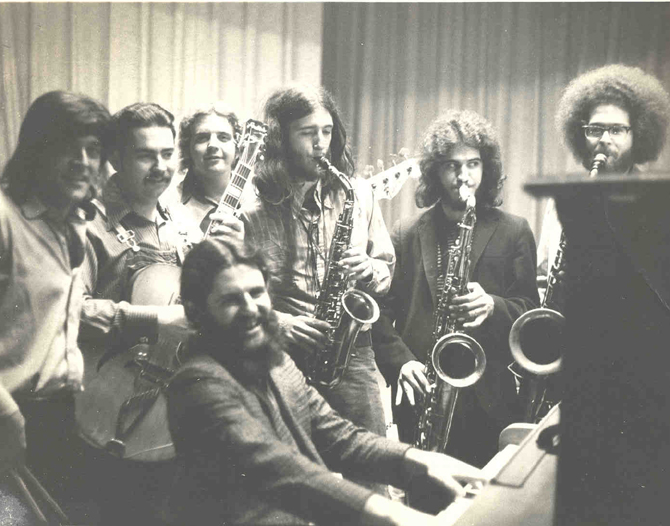
The first 7-piece Roomful (left to right): John Rossi, Duke Robillard, Ed Parnagoni, Rich Lataille, Greg Piccolo, Doug James; Al Copley in front at the piano
The repertoire and intent were drawn from a wide variety of sources such as the harder-rocking big bands of Count Basie, Illinois Jacquet and other swing era outfits which had made a deep impression on Rich Lataille; Duke’s interest in the classic R&B horn bands such as Freddie Mitchell’s and Paul Williams’ as well as the smaller R&B units which featured saxophone like Louis Jordan’s Tympany Five; and Al’s and John’s love of the larger Rock ‘n’ Roll bands which sported horn sections, particularly those under the guidance of the great New Orleans arranger and producer Dave Bartholomew including Fats Domino’s and Little Richard’s Upsetters. In addition to the “honkin'” sax sound, they incorporated a big slice of the blues “shouters” repertoire and styles (Roy Brown, Wynonie Harris, Big Joe Turner) to deepen the pool of influences from which they drew their early identity.
When all of these influences were run through the mill of the new “Roomful Of Blues,” an amazingly original sound resulted. Duke Robilard’s guitar playing had reached a new plateau in the two previous years and instead of playing straight-ahead Chicago blues with the new lineup, he was by then playing in a manner more akin to the jazzy stylings of T-Bone Walker with a dose of Charlie Christian and Oscar Moore thrown in for good measure. The horn section, with only three players, was carefully arranged to highlight signature riffs and propel the song, but to never overwhelm the rockin’ rhythm section nor vocals.
There was nothing “precious” about the original Roomful. They did not approach the music as traditionalists nor as preservationists, but rather as a vibrant, contemporary band looking to move the music into the future and recreate it in their own image. They did, of course, wear their influences on their sleeves. From the thrift shop ’40s and ’50s hipster fashions of their stage wear to their between song patter when they openly urged audiences to seek out the original recordings of the material in their repertoire, they more than paid tribute to the masters. But these were young men on a mission – they were determined to reintroduce swing, jump and horn-based blues styles to the world and hit the big time doing so. They succeeded well beyond their own expectations.
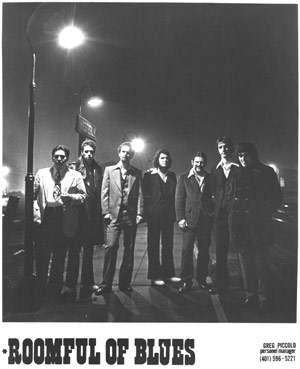
Early publicity photo for the first classic lineup of Roomful of Blues, 1975 (left to right): Duke Robillard, Preston Hubbard, Doug James, Greg Piccolo, Al Copley, Rich Lataille, John Rossi
THE DUKE ROBILLARD YEARS 1971-1979
Roomful Of Blues practically exploded onto the Rhode Island music scene. Playing whenever and wherever they could find a gig – coffeehouses, rock clubs, restaurants – their audience grew exponentially with each performance. Due to the virtuoso levels at which each of the seven musicians was playing, they could perform for a listening audience and their improvisatory skills would astound even jazz fans. Give them a dance floor to fill, and they’d have everyone out of their seats before the first chorus of the first number was over. The pivotal venue for the development of Roomful was the Knickerbocker Cafe in Westerly.
The dance hall dated back to the heyday of the Swing era (from the mid-1930s to the end of World War II) and sported a gigantic dance floor perfect for the growing number of fans who, inspired by Roomful’s hard-swinging sound, had taken up jitterbugging. The band assumed a residency at the Knick on Sunday nights working for the door which gave them free rein over the repertoire and presentation and the opportunity to try new material and arrangements. Attached to the dance hall was an old-fashioned, intimate cocktail lounge which provided a spot to hang out and review their performances and plan their next moves in relative privacy. The club became the nominal headquarters for the band for the next decade or so and, on Sunday evenings and during their frequent weekend bookings, every stylistic experiment they attempted was introduced at the Knickerbocker. Playing to their most dedicated fans and closest friends gave the group an experience not unlike the benefits of a “focus group” and allowed them to avoid the pitfalls of “road testing” new ideas.
Over the next three or four years, they gradually expanded their territory until they were one of the biggest acts in all of New England and had begun making inroads onto the New York scene. During the 1970s, they had opportunities to share the stage with many of their heroes including opening slots for Count Basie and Fats Domino and other shows where they also accompanied the stars such as Sil Austin and Arnett Cobb. They had also begun introducing original material into their act and, in 1975, the band decided to test the waters by releasing their first proper record on their own label, Room-Tone. The A-side was a Duke Robillard original, “Don’t You Want To Roll With Me,” and the B-side was their arrangement of the swing/blues chestnut “You Rascal You.” The record was well-reviewed and sold well to their fan base and, all-in-all, helped to spread the word on the band even further.
It seemed to everyone on the Rhode Island scene that it was only a matter of time until Roomful would hit “the big time,” but there was one more ingredient needed to put the finishing touch on their musical stew. For some time, the band had been eager for a change in the rhythm section sound by making the switch from electric bass guitar to upright bass fiddle and had had their eye on Preston Hubbard of Providence. Preston had come up through the late ’60s underground rock scene, but his love of jazz and blues led him to switch from bass guitar to upright by 1972 when he became a member of a local jazz group, the aforementioned The Hamilton-Bates Blue Flames, with future tenor sax jazz legend Scott Hamilton, guitarist Fred Bates, and early Roomful drummer Chuck Riggs. As the Blue Flames were all close friends of the Roomful crew, no one wanted to upset the apple cart by trying to “steal” Hubbard, but as word got around about Roomful’s search for an upright bassist, Preston expressed his interest in making the switch to Hamilton who gave his blessing.
(Order was preserved with the Blue Flames’ recruitment of bassist Phil Flanigan. The group soon lit out for the greener jazz pastures of New York City where they have all achieved incredible levels of success, especially Hamilton who is regarded as one of the finest and most successful saxophonists in the world. Their careers will also be documented by the RIMHOF Archive in the future.)
With the final piece of the puzzle in place, Roomful Of Blues continued honing their craft, refining their sound and expanding their fan base and by 1976, they’d come to the attention of Jerome “Doc” Pomus.
Doc was one of the most legendary characters on the national music scene. He was an incredibly successful hit songwriter in the R&B, Pop and Rock ‘n’ Roll arenas having scored big with such classics as “Lonely Avenue” for Ray Charles, “Save The Last Dance For Me” by The Drifters, Dion’s smash “A Teenager In Love” and “Can’t Get Used To Losing You” for Andy Williams. (This is just the tip of the iceberg! Pomus had dozens of hits and wrote hundreds more songs during his forty-year career.) He was also an incredibly generous person, acting as mentor, guide and “godfather” to many a young musical hopeful including Rhode Island’s own Peter Anders and Vini Poncia. But that’s all music business legend. What is not generally known is that Pomus had begun his career as a recording artist in the blues “shouter” tradition. From the mid-1940s to the early ’50s, he had a great run as one of the first successful white blues singers and only turned his primary attentions to songwriting when he was forced to leave his stage career for medical reasons. (Childhood polio had put him on crutches as a teen, but a bad fall later necessitated the use of a wheelchair for the rest of his life.) Horn-driven R&B was his first love and as soon as he heard Roomful Of Blues in a New York nightclub, he knew he’d have to help.
Doc realized that taking a band like Roomful around to the labels in search of a recording contract might be a hard sell, so he decided to produce a master himself and then try to get it picked up for release. Working with his friend, the hit record producer Joel Dorn (Roberta Flack, Bette Midler) whom Pomus had mentored in the 1960s, the two partners produced a perfect snapshot of Roomful Of Blues in the mid-1970s which is now considered a blues classic. Although mostly covers (three songs by Chuck Willis and two by T-Bone Walker among them), their self-titled 1977 first album is a hard-swinging affair which showcases all of the talents of all of the members and the master was snapped up by Island Records for national release. The album sold well and was well-received in the press which allowed the band to begin touring around the country. They were getting noticed by more and more people in the upper levels of show business and packing the clubs.
One interesting interlude during this period involved comedians John Belushi and Dan Ackroyd of “Saturday Night Live” fame. Belushi and Ackroyd had introduced a bit on the show involving two white R&B musicians they called “The Blues Brothers.” The recurring characters, backed by the show’s house band, became tremendously popular and offers to take the act on the road poured in. As the show’s musicians could not leave the NBC studios for road work, John and Danny were on the lookout for a backing band. They were introduced to Roomful by a mutual friend, Curtis Salgado, the lead singer of the original Robert Cray Band out of Seattle. (Belushi and Salgado had become friends – and Curtis, John’s musical mentor – when Belushi was in the northwest filming his first feature, “Animal House.”) Thinking it a perfect fit, Curtis brought the Blues Brothers to see Roomful and they agreed. Roomful backed the Blues Brothers on more than one occasion, but when Belushi and Ackroyd offered them a tour as their backing band, the group declined thinking that it might interrupt their career trajectory and/or cause them to be seen as a “novelty” act by the public. It all worked out in the end for everyone: The Blues Brothers became a major hit recording act and the subject of a feature film; Curtis continued on with the Cray band and will return to this story in a bit; and Roomful continued on their chosen path.
During the 1978-1979 period, the first cracks began to appear in the Roomful story. A second album was recorded, this time produced by Joel Dorn alone. It is another fine piece of work by the entire team, but Island, unhappy with the sales of the first album, delayed its release. (To put this into perspective, this was the era of “Frampton Comes Alive,” Fleetwood Mac’s “Rumours,” and “Kiss Alive,” albums which all sold over six million copies during their initial runs, and the major labels had turned their attentions to promoting product which they hoped would sell at least a million units. Despite selling thousands of copies and turning a clear profit for all involved, Island was unsure of what to do with the second Roomful album.) Roomful soldiered on and, in 1978, added a new instrument to the lineup for the first time since ’71, a trombone as played by another Rhode Island musician, Carl Querfurth. Doug James took a leave of absence around the same time to take advantage of an opportunity to co-lead the National Lampoon Orchestra with founder Matty Simmons’ son Mike; he was back in the fold by 1979. By the time the album was released in 1979 on Island’s budget sister label, Antilles, Duke Robillard was ready to move on. Having mastered the styles needed to present Roomful in the proper light, Duke had become interested in exploring new territories and accepted an offer to replace the legendary Link Wray in neo-Rockabilly artist Robert Gordon’s band.
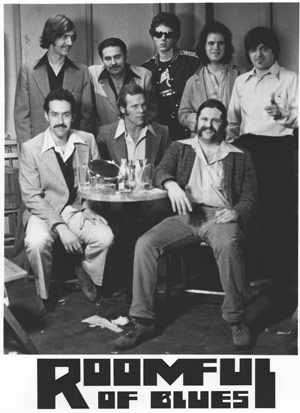
Roomful near the end of Duke’s tenure: Rich Lataille, Duke Robillard, Preston Hubbard, Greg Piccolo, John Rossi (standing left to right); Luke McMenemy, Carl Querfurth, Al Copley (seated in front)
(Duke has since gone on to become one of the most acclaimed guitarists in the history of the instrument, equally adept at everything from straight ahead, small group jazz to powerhouse electric blues on par with Stevie Ray Vaughan and Buddy Guy. His incredible post-Roomful career as both a leader and a sideman will be documented by the RIMHOF Archive in the future.)
ROOMFUL: MARK II
The first big shakeup in Roomful’s history was handled with style and aplomb by all involved. Duke gave his tacit blessing for the band to continue and assisted in the transition by continuing to make booked dates. Preston Hubbard and Carl Querfurth followed Duke out of the lineup. Al Copley and Greg Piccolo assumed the musical leadership of the organization while John Rossi, Rich Lataille and Doug James remained in place. Losing a leader often sounds the death knell for a musical group, but in Roomful’s case the stakes could have been even higher. Not only had Duke been their nominal leader, but he’d also been the frontman, lead guitarist, lead vocalist and the musical guiding light in their development. The decision was made to not attempt to “replace” Duke, but to look for a new sound and a new direction.
For a new lead guitarist, they chose Ronald Earl Horvath. Ronnie Earl was an up-and-coming guitarist who had made a name for himself on the Boston, Chicago and Austin blues scenes and had most recently been playing with singer/harmonica player Ray Norcia’s band, Sugar Ray & The Bluetones. Earl’s playing shied away from the jazzy overtones of Duke’s Roomful approach; he performed in a straight-ahead electric blues style with a ton of chops to back it up. Thanks to their touring schedule, Roomful had been through Texas many times and had made many friends on the Austin scene (these connections would continue to play an important role in Rhode Island music history for decades to come), and so, from Austin, they drafted a female vocalist, Lou Ann Barton, who had recently left Steve Ray Vaughan’s group. Hubbard was replaced by Jimmy Wimpfheimer who played both electric and upright bass which offered stylistic options to the rhythm section. They also decided to further expand the horn section by adding a trumpet and brought in Danny Motta, while Querfurth was replaced by a truly legendary musician on the Rhode Island scene, Zolman “Porky” Cohen.
Cohen was a couple of decades older than the rest of the band and was a veteran of the very scenes which had inspired Roomful in the first place. Breaking out of Providence in the early ’40s, Porky had done stints with the some of the top swing and big bands including Benny Goodman, Tommy Dorsey, Charlie Barnet, Tony Pastor and the Casa Loma Orchestra. His powerful playing and improvisational skills had gotten him noticed on the postwar R&B circuit and he became one of the only white players on that scene performing with Lucky Millinder and Wynonie Harris. After marrying, he decided to settle down and during the 1960s and ’70s had limited his performances to mainly playing general business gigs in the Rhode Island area, although he kept up his jazz chops by performing with Duke Belaire’s Big Band on Monday nights at Bovi’s Tavern in East Providence for many years and was a member for 25 years of Tony Tomasso’s Jewels Of Dixie, New England’s premier Dixieland outfit with whom he accompanied such legends as Coleman Hawkins and Louis Armstrong among many others. During the day, he worked as a clerk at Ladd’s Music stores and became known as one of the “go-to” guys for young record collectors seeking out the history and chestnuts of the big band era and the R&B scene.
The “new” Roomful Of Blues presented as a harder-edged, slightly more modern blues band and the added excitement of a superb and sexy chick singer, a hotshot guitarist, and an expanded, brassier, more powerful horn section quickly put them right back into the swing of things. The public was more than accepting of the changes and the band picked up right where it had left off. They resumed touring and began planning for a new album. Unfortunately, Barton decided to leave the band before a year was up and this lineup was never recorded for posterity. But “carry on” was now the catch phrase of the organization and it was decided that Lou Ann would not be replaced and that Greg Piccolo would step up to the center mic as lead singer. Greg adapted to his new role as frontman in no time at all, shouting the blues with the best of them, continuing to blast his tenor sax solos in his Red Prysock-influenced style, and becoming an adept and intimate purveyor of the slow blues.
When their contract with Island was not extended, the group decided to do it themselves and began recording a self-produced album to be called “Hot Little Mama.” While trying to decide what to do with the master – shop it around or release it themselves – Roomful Of Blues had a fortuitous encounter with an young Englishman whose introduction into their story would prove to be one of the most crucial turning points in their history and would help determine the band’s direction for the next two decades. Enter: Bob Bell.
Bell, like so many others of his generation in the UK, had become obsessed with American Rock ‘n’ Roll and R&B and, by his teenage years, knew that he wanted to make the music business his career. In 1965, he got his first job in sales at Chris Blackwell’s fledgling Island Records under the tutelage of Guy Stevens, who would become one of the most beloved characters and successful producers in British music history. Island’s bread and butter at the time was the licensing American R&B (James Brown, Ike & Tina Turner) and Jamaican Ska for UK release. (Their biggest hit to date had been Millie Small’s “My Boy Lollipop.”) Ska quickly assumed a place in Bob’s heart as dear to him as R&B. He stayed with the company for nearly seven years and his crowning achievement was his production of the now-legendary box set “The Trojan Records Story” which documents the early years of Caribbean R&B leading up to Reggae. (This collection would prove to be the “bible” for the music and play a pivotal role in the development of the ska revival movement in the late ’70s – The Specials, Madness, et al – much as Harry Smith’s Smithsonian folk box did for the folk revival movement in the late ’50s.)
After a seven-year break from the business during which he worked a 500 acre hill farm and tended a flock of 200 sheep, he returned to Island in 1979 to organize their Jamaican archive and raise the funds for something he’d always wanted to do: travel to America.
Shortly after his arrival in the U.S. in 1980, he was introduced to Roomful Of Blues by a friend in Atlanta where the group was beginning a three-night stand. He was knocked out and attended all three performances. He was so enamored with the band that he followed them to their next gig in New Orleans after which they briefly parted ways. He continued his travels but could not get Roomful out of his mind and lit out for Rhode Island to look them up again. The band’s two Island LPs had never been released in the UK so when they revealed the existence of a new, nearly completed Roomful album, Bob proposed that he take the master back to England to see if he could get them off the ground in Europe. The record was completed in short order at the Hit Factory in New York City and Bob caught the next flight home. He succeeded immediately and got the album picked up by Ace in the UK and Phonogram/Mercury in France. He next convinced the band that they should release “Hot Little Mama” in the U.S. themselves and laid out a business plan. As a result, the group was so amazed by his abilities that he was immediately accepted into the fold as “chief cook and bottlewasher.” He became their soundman, publicist, driver, manager and record label CEO.
The album came out on their own imprint, Blue Flame Records. Bob set up decent distribution which kept the band’s name on the record store shelves and it also allowed them to sell copies on gigs for a bit of extra income. In it’s original configuration, the album sold over 10,000 copies which was at the high end of the sales spectrum for blues recordings at the time. With Greg on lead vocals, the album was a perfect representation of the new sound. While it had been their hope that the album would assist in their quest for a new record label, nothing materialized. The band was as popular as ever, though, and there was plenty of work, so in 1981, they decided to hit the road, but not before another personnel change occurred when Danny Motta was replaced by Bob Enos on the eve of their first coast-to-coast tour.
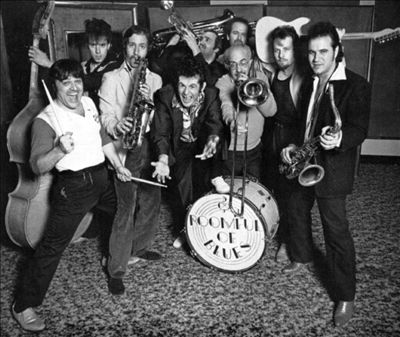
Preston Hubbard, Bob Enos, Doug James (back row); John Rossi, Rich Lataille, Al Copley, Porky Cohen, Greg Piccolo (front row)
Enos was a fine jazz player who had made a name for himself working with one of Rhode Island’s most legendary jazz outfits, Greg Abate’s Channel One, a incredibly tight and talented unit which straddled the ground between small group, modern jazz and the less-commercial aspects of the jazz-rock “fusion” movement. He’d also spent two years on the road playing behind Herb Reed’s Platters fronted at that time by the incredible Nate Nelson, formerly of The Flamingos. Bob’s huge, powerful tone and the depth of his skills as an improviser made him a perfect choice for Roomful and when he was offered the trumpet chair, he accepted. Also in 1982, opportunity came knocking with an offer to record behind the legendary blues man Eddie “Cleanhead” Vinson. Roomful was the perfect choice to help return the great singer/songwriter/alto sax player to the public eye and both the album, released on the jazz label, Muse Records, which gave the band its first Grammy nomination, and the resulting live performances were very well received.
It was during this period that the revolving door effect one gets from looking at the personnel changes in Roomful through the years begins to rear its head: Preston Hubbard returned to fold (this time playing both upright and electric to cover the changes effected during Wimfheimer’s run) and to celebrate, the band recorded a new single which they released back on their original, homegrown label Room-Tone in late 1982.
1983 proved a pivotal year for the band. They accepted another offer from Muse to record an album behind Big Joe Turner. Turner was not only one of the greatest living blues shouters with a career dating back to the 1930s, but was one of the band’s greatest heroes and biggest influences. This project was especially dear to Al Copley as some of Turner’s most successful recordings were the piano/vocal duets he performed with boogie woogie giant Pete Johnson. The album (which earned Roomful their second Grammy nomination) and the tour which followed were both tremendous successes and put Roomful squarely back on the map.
Bob Bell secured a new recording contract with Varrick Records, a subsidiary of the most successful independent record company in the U.S. at that time, Rounder Records of Cambridge, Massachussets. The band’s “Dressed Up To Get Messed Up” was a giant step forward for the group, even better than the excellent “Hot Little Mama,” and pointed them clearly toward the future. Not only was Greg confidently settling into his role as lead singer, but, encouraged by Bob, he contributed seven original songs to the project and produced the album as well. Sales were brisk and thanks to the album’s success, Bell was also able to negotiate a Rounder reissue of “Hot Little Mama” as well.
Guided by Greg and Bob, Roomful were riding high for a couple of years in the mid 1980s, touring not just throughout the United States, but thanks to the Bob’s inexhaustible enthusiasm and devotion, they were able to extend their territory into Europe. Things were looking bright, but so, it seems, that must be the cue for another shake-up! In 1984, founding member Al Copley announced he would be leaving the band to move to Europe and pursue a solo career. It didn’t take them long to find a perfect replacement: Ron Levy. Levy was a Boston area player who had extensive touring experience, first behind guitar-slinger Albert King, then followed by a nine-year/nine album run with B.B. King . Ron was not only a great pianist, but he was even better known for his work on the Hammond organ which would add new textures and timbres to the band’s sound. He was also a fine singer and his nightly vocal features would quickly become audience favorites. Also in ’84, Greg underwent surgery for polyps on his vocal cords and the band brought in a temporary replacement on lead vocals, Keith Dunn, a nephew of the legendary Jimmy McCracklin. Keith was with the band for about six months during Greg’s recovery.
More changes followed in 1985 when Preston Hubbard left for the second and last time to join former Roomful drummer Fran Christina in a revamped lineup of the popular Austin based band, The Fabulous Thunderbirds. (This lineup of the Thunderbirds which featured singer/harmonica player Kim Wilson and lead guitarist Jimmie Ray Vaughan, the brother of Stevie Ray, would go on to become one of the most successful blues acts in history and the story of their Rhode Island rhythm section will be duly covered by the Archive in the future.) Preston was replaced by Rory MacLeod, one of the band’s biggest fans and closest friends and a tremendous player, equally adept on the upright and electric basses. While they were at it, the band must have decided they should just “go for it” and Greg decided to step back into the horn section and turn over center stage to a new lead singer, their old friend, Curtis Salgado. In 1986, this lineup recorded two albums, both of which are now considered classics. The first was a live recording which fully captured the power and brilliance of this era of the band, “Live At Lupo’s Heartbreak Hotel.” Lupo’s was a showcase club in downtown Providence, Rhode Island which had become Roomful’s new home base since the Knickerbocker Cafe era and was the perfect place to get the band down on tape. The second album was another collaboration, this time with the great New Orleans singer/songwriter and guitar hero, Earl King. Released on Black Top Records, this album is the best-selling record of King’s career and a truly shining moment for Roomful Of Blues. It earned the band its third Grammy nomination.
From 1986 to 1994, Roomful was without a record contract, but that did not stop them from barnstorming the world. Their calendar was as full as ever and they were in-demand for club dates, concert appearances and major blues festivals. There were more changes over the years. Salgado left in 1987 which saw Greg returning to center stage. The same year marked the return of Carl Querfurth on the trombone. Carl envisioned a Roomful as an institution with a long-term future and assumed the role of bandleader; he and Bob began to lay out a business plan. All the while, musicians continued to come and go. The same year saw the departure of Ronnie Earl to transform his side project, the Broadcasters, into a full time unit reuniting him with Sugar Ray Norcia as his frontman. The guitar slot was at first filled by Thomas “Tommy K” Kay. Next, Ron Levy also took his leave joining, at first, Ronnie’s band for an album and tour, and then, after recording a second album, accepting an in-house producer’s position at Rounder Records. He was replaced by Junior Brantley, whom Roomful had gotten to know when he was working with the T-Birds. Junior was with the band for several years, and was extremely popular with the fans. He looked a bit like Little Richard, and was often stopped in airports and asked if, indeed, that was who he was. During his run, the band made their first feature film appearance in Rich Lupo’s and Jim Wolpaw’s “It’s A Complex World.”
In 1987, the band also appeared in, and contributed three songs to the soundtrack of, a major studio motion picture called “The Good Mother.” Shot in Boston (and released in 1988), the movie starred Diane Keaton and Liam Neeson and was directed by Leonard Nimoy of “Star Trek” fame. “Mr. Spock” produced the three Roomful tracks! Before the year was up, however, more shakeups occurred: Porky retired and Rory MacLeod was replaced by Rhandy Simmons, who in turn was replaced by Paul Tomasello.
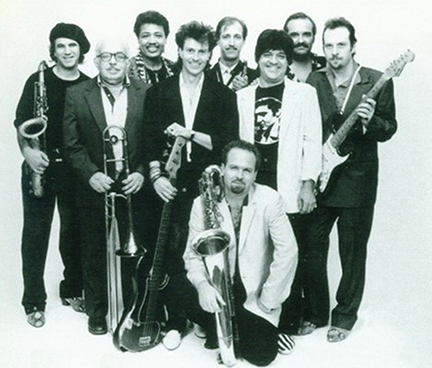
Roomful of Blues 1987. One of the many lineups of the band during the transitionary years between record deals (1986-1994). Back row, left to right: Greg Piccolo, Junior Brantley, Rich Lataille, Bob Enos, Ronnie Earl. Center row, left to right: Porky Cohen, Paul Tomasello, John Rossi. Kneeling in front: Doug James.
In 1990, Tommy K left the group and the quest for a new guitarist began. Roomful resorted to an unusual search method. Instead of taking time off to audition guitarists, they offered temporary positions to several of the finest blues guitarists on the scene whose auditions became “trial by fire” as they vied for the slot live on stage with the band rather than in the privacy of a rehearsal studio. When all was said and done, one player stood out from the pack and his recruitment would later prove to be another crucial point in the history of Roomful Of Blues. They hired Chris Vachon.
Vachon was one of the young guns on the Rhode Island scene having made his name as guitarist Thom Enright’s partner in The Spotfinders, one of the more successful blues-based bands at the time. Vachon was not only a fine guitarist who’d be able to cover the ground pioneered by his predecessors Duke and Ronnie (and any other style for that matter), but he had developed his own unique sound, intense and emotional, and backed up by an incredible set of chops. Chris had also made a name for himself as a songwriter and represented an opportunity for the band to acquire much-needed new original material in the future. Chris was young and he was driven. He had a deep respect for the past, especially Roomful’s own history, but he was not there to see the band rest on their laurels. He was a forward thinker and it was recognized that this was a musician who could help propel Roomful Of Blues into the future.
1991 proved an interesting year for the band with an unexpected offer from rock singer Pat Benatar and her partner, Neil Giraldo, her husband, guitarist and band leader. Pat and Neil were looking to re-explore their blues roots and, with the backing of their label, Chrysalis, cut an album called “True Love” utilizing the entire Roomful horn section and drummer John Rossi. The record was a left-field hit and ultimately sold over 350,000 copies. The guys toured behind her and made several television appearances including two shots on The Tonight Show Starring Johnny Carson and The Arsenio Hall Show. The rest of the band accompanied the Benatar organization on the tour with Bob Bell arranging late-night club dates for the entire band after the Benatar concerts finished.
Right after the Benatar project was completed, the band once again re-booted with the recruitment of a new lead singer, none other than Sugar Ray Norcia. Greg had once again been looking to step back into the horn section and was short on new material after releasing his first solo album “Heavy Juice” on Black Top Records in 1990. Bringing in Ray not only gave the band a new lead singer, but introduced a new instrument into the mix for the first time in years, the harmonica. Ray was also a songwriter and would be able to provide the band with new original material.
In 1992, more personnel changes followed with Matt McCabe coming in on keyboards and Kenny “Doc” Grace of the popular Rhode Island blues unit (and Carl Querfurth’s former band) Loaded Dice sliding into the bass guitar slot.
ROOMFUL IN TRANSITION
By 1993, the band had coalesced into a new, very solid 10-piece lineup retaining four original members (drummer John Rossi, and the three sax players, Greg Piccolo, Doug James and Rich Lataille), three, by-then, stalwarts of the group (Chris Vachon, Bob Enos and Carl Querfurth) plus three relative newcomers (Matt McCabe, Kenny Grace and Ray Norcia). They recorded a new album but left it in the can for the time being. Before getting back to “Roomful” business, the group took one more detour – they accepted an offer from Canadian superstar Colin James for John Rossi and the horn section to cut an album and tour behind him as members of what he termed his “Little Big Band.” The album was a double platinum success in “the great white north” and a massive tour encompassing the entire length of Canada was to follow, this time with the entire Roomful Of Blues as the opening act on each show. Once the album was completed however, Greg Piccolo announced that he would be leaving Roomful to pursue a solo career. In order to cover the arrangements on the album, the band would need a tenor man so they brought in “Sax” Gordon Beadle for the first leg of the tour and then Kevin May for the second half.
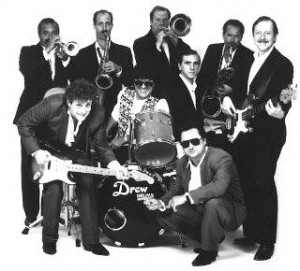
Roomful 1996 (left to right): Bob Enos, Chris Vachon, Rich Lataille, John Rossi, Carl Querfurth, Matt McCabe, Ray Norcia, Doug James, Ken Grace
Armed with the band’s critical acclaim, continued popularity, the high visibility gained from the Benatar and James projects, and the power of their live performances, Bob Bell negotiated a new recording contract with another Rounder Records subsidiary, Bullseye Blues which had been founded in 1991 by none other than their old pal and bandmate, Ron Levy! The band unleashed their previously recorded album “Dance All Night” on the world in 1994. It is a powerful record produced by Carl which showcases shining performances by Chris, Greg, and Ray who also contributed three original songs to the project. The sales of the album guaranteed that Roomful would have a home for their product for the foreseeable future and the future looked bright, indeed! And although Greg had left the band since the time the album was recorded, he was not replaced. The group carried on as a 9-piece with alto man Rich Lataille doubling more heavily on tenor.
The following year, they returned to the studio to record their second album for Bullseye, an album which is a milestone in their career. “Turn It On! Turn It Up!” is not only one of their best-selling albums, but it earned them their fourth Grammy nomination, the first for a strictly Roomful project. (The first three Grammy nods had been for their earlier collaborations with the older bluesmen Cleanhead Vinson, Joe Turner and Earl King.) The album also marks the emergence of Chris Vachon as a major creative force in the group: he co-produced the album with Carl and composed the title track.
(Three years later, this album got another shot-in-the-arm when several of its tracks were included in the soundtrack of another motion picture, 1998’s “Code Of Ethics,” shot in Rhode Island and starring comedian Pat Cooper and future Oscar winner Melissa Leo.)
Later in 1995, the band recorded behind their former trombonist Porky Cohen for another Bullseye release. Produced by Carl, the album, “Rhythm & Bones,” showcases the then-70 year old Cohen at his finest in a program of swing, jump and blues celebrating his entire career in the process. It was Porky’s only solo album. He passed away in 2004 leaving behind an incredible musical legacy achieved during a career which stretched across seven decades. His dedication to music can best be summed up by a statement from Bob Bell who points out that Porky Cohen was, “the only musician to have performed with both W. C. Handy and Stevie Ray Vaughan. Now that is a stretch of history!”
This lineup of the band proved one of the most stable in the group’s history touring steadily for four years and recording two more albums for Bullseye, “Under One Roof” and a perennial best-seller, the holiday favorite “A Roomful Of Christmas.”
CHRIS VACHON AND THE MODERN ERA
In 1997, Carl Querfurth decided to leave the band and many of the others followed suit. That development put Chris Vachon solidly in control of the band’s musical direction and he and Bob Bell reorganized the band to not only move the music forward, but to put a new business plan in place with an eye to a long-term future. Thanks to his decades of experience, Bob recognized the changing face of the music business long before it became apparent to most and, in a cost-cutting measure, returned to the road, driving the bus and selling merchandise while utilizing the then-recent technologies of the internet and cellular phones to conduct the band’s business from remote locations. Mac Odom was signed on as the new lead singer; bassist par excellence Marty Ballou came on board; Al Weisman took over the keyboards; and the horn section was revamped with John Wolf and Kevin May coming in on trombone and baritone sax respectively and Bob Enos remaining on trumpet. With only two original members remaining, John Rossi and Rich Lataille, a new day was dawning for Roomful Of Blues.
1998 saw the release of “There Goes The Neighborhood,” a step forward in the band’s sound. It’s a very solid album produced by Chris (with an assist from one of Rhode Island’s most legendary producers/engineers, Phil Greene) and points the band in a new direction – sleeker, more “modern,” but still swinging like crazy. More changes followed in the lineup when Marty left to be replaced by Greg Silva and Steve Kostakes replacing Al Weissman on the keyboards.
Another personnel shift led into the recording of 2001’s “Watch You When You Go” which introduced Hank Walther on keyboards, Ray Gennari on trombone and the arrival of legendary Rhode Island guitarist/bass guitarist Thom Enright (earlier Chris’s partner in The Spotfinders) who brought along a new source of original material when he assumed bass duties. It also marked the departure of drummer John Rossi leaving Rich Lataille as “last man standing” from the original lineup. He was replaced by Chris Lemp. It’s another fine album produced by Chris and clearly points the way to where the band is today. The album marked the end of their deal with Bullseye/Rounder and the following year, a live recording featuring this lineup, “Live At Wolf Trap,” was released on the band’s own Room-Tone label as a stop-gap measure until another deal could be secured.
By the middle of 2001, Bob Bell was tiring of the road and began a period of transition which saw him assist the band in one more revamp of the lineup with Mark DuFresne, a fine singer from Oregon, coming in to front the band and Mark Earley settling into the baritone sax chair. In May of 2002, Bob bid farewell to Roomful Of Blues and headed for Oakland, California to revamp his life as he’d helped to revamp the band so many times.
(Bob Bell still has his hand in the musical pot. He’s been participating in the production of and writing liner notes for various Reggae reissues for his old employers, Trojan Records and is assisting in a career change for Rusty Zinn, a fine vocalist and guitarist who made an international name for himself in the blues world during the 1980s and ’90s, but who, for the last decade, has immersed himself in Jamaican music.)
With Bell’s departure, Chris Vachon assumed control over virtually every aspect of Roomful Of Blues. His first order of business was yet another revamp of the lineup: Thom Enright departed and was replaced by Brad Hallen; Jason Corbiere came in on drums replacing Chris Lemp; and Mark Stevens took over the keyboard chair from Hank Walther. Recording commenced for a new album while the search for a new label began. Chris Vachon, again in the producer’s chair, guided the band through an album which is his crowning achievement. “That’s Right!” was released on the mighty Alligator Records in 2003.
An album of fourteen cover tunes, the album amounts to an armchair travel program which takes the listener on a virtual journey through the history of post-war blues. It pays homage to every stylistic innovation in the genre and acknowledges every major influence on the band since its inception: the small group Rhythm & Blues of Chris Powell & The Blue Flames; the guitar heroes (B.B. King, Fenton Robinson); the musical stew of New Orleans (Eddie Bo, Smiley Lewis); the Memphis connection (Big Maybelle, Ike Turner & The Kings Of Rhythm); the honkin’ sax of Red Prysock; the great blues shouters with two from Big Joe Turner; the “soul” end of things (Jimmy McCracklin, Little Milton); the electrified country blues of Elmore James; and, of course, a nod to T. Bone Walker, the band’s most primal influence bar Buddy Johnson. The album, however, is not a re-creation of these styles in any sense. It is thoroughly modern and utterly original in both its production and performance. Like the “classic” lineup of the band in the Duke Robillard era, the Roomful of 2003 was intent on making the music their own, setting the bar higher than it had ever been. “That’s Right!” flicks on the high beams lighting the way to the future for not only the band, but for the blues itself. The music-buying public and the critics agreed. The album became a best-seller and earned the band its fifth Grammy nod (the second for a Roomful album, their fifth altogether).
The next album, “Standing Room Only,” was another step forward. With only one personnel change since the previous recording when Travis Colby joined as the new keyboard player, the album relies heavily on original material with songs coming from Vachon, DuFresne, Lataille, Colby and Earley. It is twenty-first century blues at its best. For the next three years, the band could be found doing what they do best – traveling the world, preaching the blues to all comers. Several personnel changes occurred. Dave Howard, well-known throughout the northeast from his days as frontman for Young Neil & The Vipers and his own unit, The High Rollers, was brought in to replace the departing Dufresne as lead vocalist. The rhythm section changed over to Dimitri Gorodetsky on upright and bass guitar and Ephraim Lowell entered the picture on drums. 2008 saw the release of “Raisin’ A Ruckus” which explored the same territory as “Standing Room” by liberally sprinkling songs by Vachon, Colby, Earley, Lataille and Howard into the mix as well as featuring an original, “While I Can, ” from Chris’s wife Bethie Vachon who also duets on the track.
The band took off on tour to promote the album when tragedy struck. Trumpeter Bob Enos passed away in his sleep after a show in Georgia; he was 60 years old and had been with the band for 28 years. The band soldiered on bringing back John Wolf who had previously played trombone with the band in the late 1990s. Wolf stayed for a year and a half and was replaced by acclaimed player and educator Doug Woolverton. One more change brings us up to the next recording with the arrival of John Turner on bass. This lineup cut the next Roomful album called “Hook, Line & Sinker” and it was another winner. Once again, the group returned to the well for another batch of covers, this time leading all the way back to Duke Ellington! This is the modern-day Roomful Of Blues at its finest. With all eight members at the peak of their powers, the band was in a position try their hand at any style while still maintaining continuity and originality.
Since the album’s release, the entire membership of Roomful Of Blues – over 50 musicians – was inducted into the Rhode Island Music Hall Of Fame in February, 2012 in an emotional and entertaining ceremony conducted by Rhode Island music writer and blues musician Bob Angell and the band’s longtime manager, Bob Bell, who flew in from Oakland for the occasion. Highlights of the band’s performance following the induction were a guest spot by Duke Robillard, and the onstage arrival of Greg Piccolo and Doug James to join Rich Lataille in reuniting the original horn section for the first time in many a year. More than two dozen other former members were in attendance to receive commemorative awards. As of this writing (summer, 2012), there has (of course) been one more personnel change with drummer Chris Rivelli signing on to replace Ephraim Lowell.
With Chris at the helm and Rich as his First Mate, Roomful Of Blues looks poised to carry on into the foreseeable future, taking the band, their audience and the blues itself into new and uncharted waters secure in the knowledge that whenever they take the stage, there will be a room full of blues and that the blues can make you happy, too.
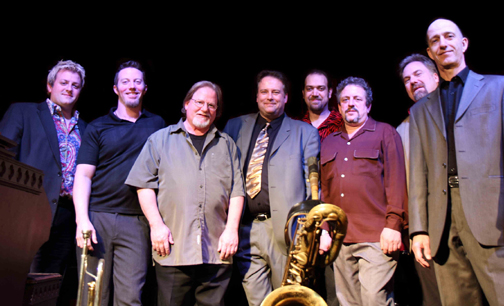
Roomful of Blues 2012 (left to right): Doug Woolverton, Travis Colby, John Turner, Phil Pemberton, Ephraim Lowell, Chris Vachon, Mark Earley, Rich Lataille
THE ROOMFUL OF BLUES DISCOGRAPHY:
ORIGINAL RELEASES
by Rick Bellaire
Each entry reflects its original configuration/cover art on release. With very few exceptions (for instance, the Room-Tone singles and the “Live At Wolf Trap” CD), all of the band’s material has been reissued and is currently available on CD and/or by download
1968
Demo Recording (East Coast Sound 10″ acetate)
Produced by Mike Robillard
The earliest known recordings by Roomful Of Blues
Side A
1. A&M Strut
2. Can’t Hide Out Much Longer
3. The Same Thing
Side B
1. Cold Blooded Woman
2. Sugar Mama
Mike Robillard: Guitar
Al Copley: Piano
Tony Lamb: Vocals, harmonica
Larry Peduzzi: Bass
Charlie Riggs: Drums
George Peterie: Rhythm guitar
(Label scan and information courtesy collection of Ronald Martinez/Beacon Agency)
1975
Don’t You Want To Roll With Me b/w You Rascal You
(Room-Tone Records 45 RT-1001)
Produced by Duke Robillard & Bob Kaminsky
The first Roomful Of Blues record
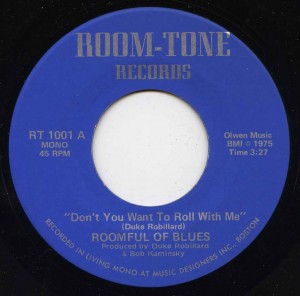 Duke Robillard: Guitar, vocals
Duke Robillard: Guitar, vocals
Doug James: Baritone saxophone
Greg Piccolo: Tenor saxophone
Al Copley: Piano
John Rossi: Drums
Ed Parnagoni: Bass
Richard Lataille: Alto saxophone
1977
Roomful of Blues (Island Records LP ILPS-9474)
Produced by Doc Pomus & Joel Dorn
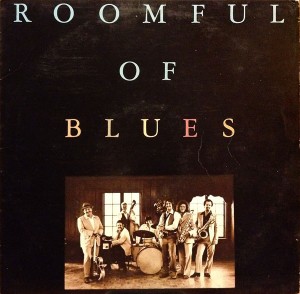 Duke Robillard: Guitar, vocals
Duke Robillard: Guitar, vocals
Doug James: Baritone saxophone
Greg Piccolo: Tenor saxophone
Al Copley: Piano
John Rossi: Drums
Preston Hubbard: Acoustic bass
Richard Lataille: Alto saxophone
with
Scott Hamilton: Tenor Saxophone
1979
Let’s Have a Party (Antilles Records LP AN-7071)
Produced by Joel Dorn
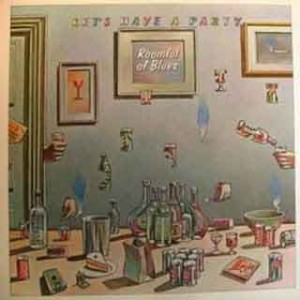 Rich Lataille: Alto saxophone
Rich Lataille: Alto saxophone
Doug James: Baritone saxophone
Preston Hubbard: Bass
John Rossi: Drums
Duke Robillard: Guitar, vocals
Al Copley: Piano
Greg Piccolo: Tenor Saxophone
1980
Hot Little Mama (Blue Flame Records LP BLUF-1001)
Produced by Roomful Of Blues
Ronnie Earl Horvath: Guitar
Rich Lataille: Alto saxophone
Greg Piccolo: Vocals, tenor saxophone
Mr. Low (Doug James): Baritone saxophone
Danny Motta: Trumpet
Porky Cohen: Trombone
Al Copley: Piano
Jimmy Wimfheimer: Bass fiddle, bass guitar
John Rossi: Drums
1982
Reelin’ & Rockin’ b/w Please Don’t Leave (Room-Tone Records 45 RT-1002)
Produced by Roomful Of Blues
Doug James: Baritone saxophone
Ronnie Earl: Guitar
Greg Piccolo: Vocals, tenor saxophone
Porky Cohen: Trombone
Al Copley: Piano
Rich Lataille: Alto saxophone, tenor saxophone
Bob Enos: Trumpet
John Rossi: Drums
Preston Hubbard: Bass fiddle, bass guitar
1984
Dressed Up to Get Messed Up (Varrick Records LP VR-018)
Produced by Greg Piccolo
Executive Producers: Roomful Of Blues
Doug James: Baritone saxophone
Ronnie Earl: Guitar
Greg Piccolo: Vocals, tenor saxophone
Porky Cohen: Trombone
Al Copley: Piano
Rich Lataille: Alto saxophone, tenor saxophone
Bob Enos: Trumpet
John Rossi: Drums
Preston Hubbard: Bass fiddle, bass guitar
with
Kim Wilson: Vocal
Rory MacLeod: Bass fiddle
John LaMoia: Percussion
14 Karat Soul (Glenny T., David Thurmond, Russell Fox II,
Brian Simpson, Reginald Brisbon): Backing vocals
1986
Live at Lupo’s Heartbreak Hotel (Varrick Records LP VR-024)
Produced by Greg Piccolo, Doug James & Roomful Of Blues
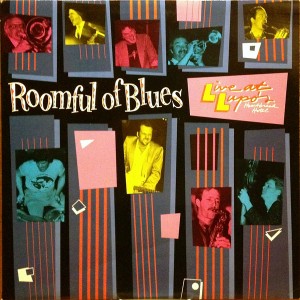 Bob Enos: Trumpet, vocal
Bob Enos: Trumpet, vocal
Porky Cohen: Trombone
Rich Lataille: Alto saxophone, tenor saxophone
Greg Piccolo: Tenor saxophone, vocals
Doug James: Baritone saxophone
Ron Levy: Keyboards, vocal
Ronnie Earl Horvath: Guitar
Rory MacLeod: Bass fiddle, bass guitar
John Rossi: Drums
Curtis Salgado: Vocals
1994
Dance All Night (Bullseye Blues CD BEYE-9555)
Produced by Carl Querfurth
Executive Producers: Bob Bell & Carl Querfurth
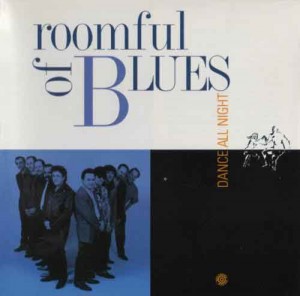 Sugar Ray Norcia: Vocals, harmonica
Sugar Ray Norcia: Vocals, harmonica
Chris Vachon: Guitar
Rich Lataille: Alto saxophone
Greg Piccolo: Tenor saxophone
Doug James: Baritone saxophone
Bob Enos: Trumpet
Carl Querfurth: Trombone
Matt McCabe: Piano
John Rossi: Drums
Ken “Doc” Grace: Bass
1995
Turn It On! Turn It Up! (Bullseye Blues CD BEYE-9566)
Produced by Carl Querfurth
Assistant Producer: Chris Vachon
Executive Producers: Bob Bell & Carl Querfurth
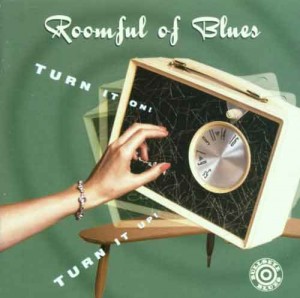 Sugar Ray Norcia: Vocals, harmonica
Sugar Ray Norcia: Vocals, harmonica
Chris Vachon: Guitar
Bob Enos: Trumpet
Carl Querfurth: Trombone
Rich Lataille: Alto saxophone, tenor saxophone
Doug James: Baritone saxophone
Matt McCabe: Piano
Ken “Doc” Grace: Bass
John Rossi: Drums
1996
White Christmas b/w The Christmas Song
(Rounder Select Records CD5 60829)
Produced by Carl Querfurth
Executive Producers: Bob Bell & Carl Querfurth
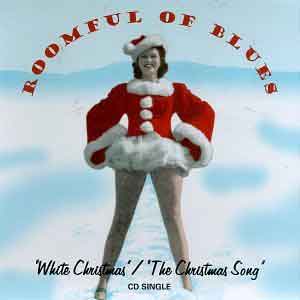 Matt McCabe: Piano
Matt McCabe: Piano
Sugar Ray Norcia: Vocals, harmonica
Carl Querfurth: Trombone
John Rossi: Drums
Chris Vachon: Guitar
Bob Enos: Trumpet
Ken “Doc” Grace: Bass
Doug James: Baritone saxophone
Rich Lataille: Alto saxophone, tenor saxophone
1997
Under One Roof (Bullseye Blues CD BEYE-9569)
Produced by Carl Querfurth
Associate Producer: Chris Vachon
Executive Producers: Bob Bell & Carl Querfurth
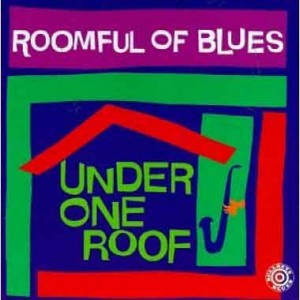 Matt McCabe: Piano
Matt McCabe: Piano
Sugar Ray Norcia: Vocals, harmonica
Carl Querfurth: Trombone
John Rossi: Drums
Chris Vachon: Guitar
Bob Enos: Trumpet
Ken “Doc” Grace: Bass
Doug James: Baritone saxophone
Rich Lataille: Alto saxophone, tenor saxophone
1997
Running Out Of Time b/w Farmer John non-album live version
(Bullseye Blues CD5 BB-4611)
Produced by Carl Querfurth
Associate Producer: Chris Vachon
Executive Producers: Bob Bell & Carl Querfurth
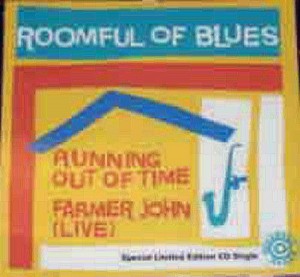 Matt McCabe: Piano
Matt McCabe: Piano
Sugar Ray Norcia: Vocals, harmonica
Carl Querfurth: Trombone
John Rossi: Drums
Chris Vachon: Guitar
Bob Enos: Trumpet
Ken “Doc” Grace: Bass
Doug James: Baritone saxophone
Rich Lataille: Alto saxophone, tenor saxophone
1997
Roomful of Christmas (Bullseye Blues CD BEYE-9591)
Produced by Carl Querfurth
Executive Producers: Bob Bell & Carl Querfurth
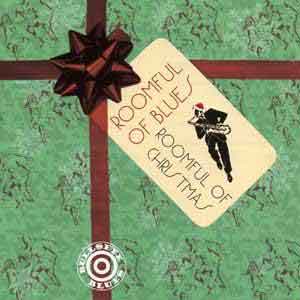 Matt McCabe: Piano
Matt McCabe: Piano
Sugar Ray Norcia: Vocals
Carl Querfurth: Trombone
Bob Enos: Trumpet
Rich Lataille: Alto saxophone, tenor saxophone
Doug James: Baritone Saxophone
Chris Vachon: Guitar
Ken “Doc” Grace: Bass
John Rossi: Drums
1998
There Goes The Neighborhood (Bullseye Blues CD BEYE-9609)
Produced by Chris Vachon & Phil Greene
Executive Producers: Bob Bell & Chris Vachon
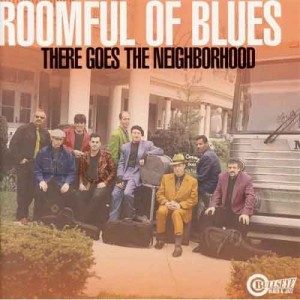 Mac Odom: Vocals
Mac Odom: Vocals
Chris Vachon: Guitar
Rich Lataille: Alto saxophone, tenor saxophone
Kevin May: Baritone saxophone
Bob Enos: Trumpet
John Wolf: Trombone, bass trombone
Albert Weisman: Organ
Marty Ballou: Bass
John Rossi: Drums
2001
Watch You When You Go (Bullseye Blues CD BEYE-9638)
Produced by Chris Vachon
Executive Producer: Bob Bell
Mac Odom: Vocals
Chris Vachon: Guitar
Rich Lataille: Tenor saxophone
Bob Enos: Trumpet
Ray Gennari: Trombone
Hank Walther: Keyboards
Thom Enright: Bass
Chris Lemp: Drums except
Tom Petteruti: Drums on “Watch You When You Go”
2002
Live at Wolf Trap (Room-Tone Records CD RT-1004)
Produced by Chris Vachon
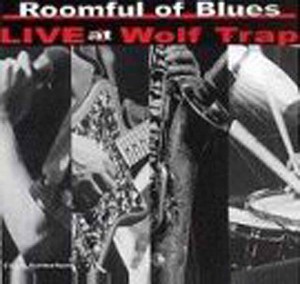 Mac Odom: Vocals
Mac Odom: Vocals
Chris Vachon: Guitar
Rich Lataille: Tenor saxophone
Bob Enos: Trumpet
Ray Gennari: Trombone
Hank Walther: Keyboards
Thom Enright: Bass
Chris Lemp: Drums
2003
That’s Right! (Alligator Records CD ALCD-3889)
Produced by Chris Vachon
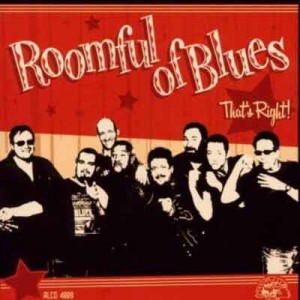 Mark Stevens: Keyboards
Mark Stevens: Keyboards
Chris Vachon: Guitar
Mark DuFresne: Vocals, harmonica
Mark Earley: Baritone saxophone, tenor saxophone
Jason Corbiere: Drums, percussion
Bob Enos: Trumpet
Brad Hallen: Bass
Rich Lataille: Alto saxophone, Tenor saxophone
2005
Standing Room Only (Alligator Records CD ALCD-4900)
Produced by Chris Vachon
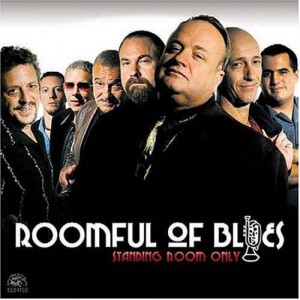 Travis Colby: Keyboards
Travis Colby: Keyboards
Chris Vachon: Guitar
Mark DuFresne: Vocals, harmonica
Mark Earley: Baritone saxophone, tenor saxophone
Jason Corbiere: Drums, percussion
Bob Enos: Trumpet
Brad Hallen: Bass
Rich Lataille: Alto saxophone, Tenor saxophone
2008
Raisin’ A Ruckus (Alligator Records CD ALCD-4919)
Produced by Chris Vachon
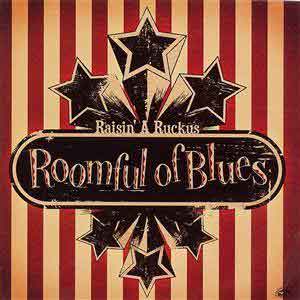 Chris Vachon: Guitar
Chris Vachon: Guitar
Mark Earley: Tenor saxophone, baritone saxophone
Travis Colby: Keyboards
Dave Howard: Vocals, harmonica
Bob Enos: Trumpet
Rich Lataille: Also saxophone, tenor saxophone
Dimitri Gorodetsky: Upright bass, bass guitar
Ephraim Lowell: Drums
with
Bethie Vachon: Vocals
2011
Hook, Line & Sinker (Alligator Records CD ALCD-4941)
Produced by Chris Vachon
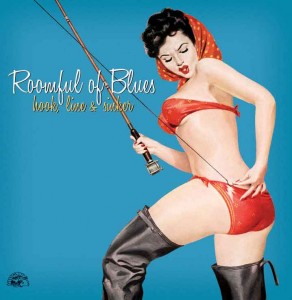 Phil Pemberton: Vocals
Phil Pemberton: Vocals
Chris Vachon: Guitar
Rich Lataille: Alto saxophone, tenor saxophone
Mark Earley: Tenor saxophone, baritone saxophone
Doug Woolverton: Trumpet
Travis Colby: Keyboards
John Turner: Upright bass
Ephraim Lowell: Drums
COLLABORATIONS WITH OTHER ARTISTS
1980
LOU RAWLS
Shades Of Blue (Philadelphia International Records LP 36774)
Produced by Joel Dorn
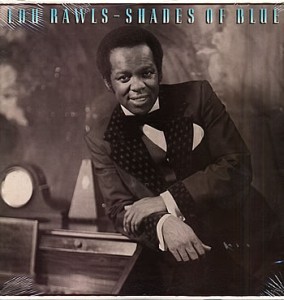 Roomful of Blues backs the singer on one track, “Think”
Roomful of Blues backs the singer on one track, “Think”
Ronnie Earl Horvath: Guitar
Rich Lataille: Alto saxophone
Greg Piccolo: Vocals, tenor saxophone
Mr. Low (Doug James): Baritone saxophone
Danny Motta: Trumpet
Porky Cohen: Trombone
Al Copley: Piano
Jimmy Wimfheimer: Bass fiddle, bass guitar
John Rossi: Drums
1982
EDDIE “CLEANHEAD” VINSON & ROOMFUL OF BLUES
Eddie “Cleanhead”Vinson & Roomful of Blues (Muse Records LP MR-5282)
Produced by Bob Porter
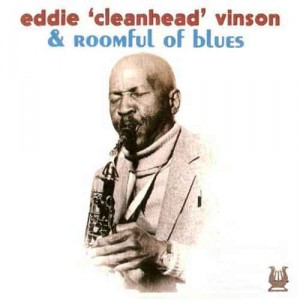 Eddie “Cleanhead” Vinson: Alto saxophone, vocals
Eddie “Cleanhead” Vinson: Alto saxophone, vocals
Al Copley: Piano
Bob Enos: Trumpet
Doug James: Baritone saxophone
Greg Piccolo: Leader, tenor saxophone
Jimmy Wimpfheimer: Bass
John Rossi: Drums
Porky Cohen: Trombone
Rich Lataille: Alto saxophone
Ronnie Earl Horvath: Guitar
1983
BIG JOE TURNER & ROOMFUL OF BLUES
Blues Train with special guest Dr. John (Muse Records LP 5293)
Produced by Doc Pomus & Bob Porter
Big Joe Turner: Vocals
Doug James: Baritone saxophone
Greg Piccolo: Tenor saxophone
Porky Cohen: Trombone
Al Copley: Piano
Rich Lataille: Alto saxophone
Bob Enos: Trumpet
John Rossi: Drums
Preston Hubbard: Bass
Ronnie Earl Horvath: Guitar
with
Dr. John: Piano
1986
EARL KING & ROOMFUL OF BLUES
Glazed (Black Top Records LP BT-1035)
Produced by Hammond Scott
Executive Producer: Nauman S. Scott
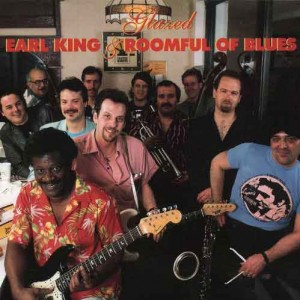 Earl King: Vocals, guitar, piano
Earl King: Vocals, guitar, piano
Rory MacLeod: Upright bass, bass guitar
Greg Piccolo: Tenor saxophone
John Rossi: Drums
Curtis Salgado: Vocals
Porky Cohen: Trombone
Bob Enos: Trombone
Doug James: Baritone saxophone
Rich Lataille: Alto saxophone
Ron Levy: Keyboards
Ronnie Earl Horvath: Guitar
1991
PAT BENATAR
True Love (Chrysalis Records CD F2-21805)
Produced by Neil Giraldo
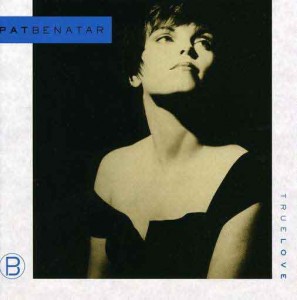 The Pat Benatar Band
The Pat Benatar Band
Pat Benatar: Vocals
Neil Giraldo: Guitar
Charlie Giordano: Keyboards, accordion
Chuck Domanico: Bass
Myron Grombacher: Drums
with
Lenny Castro: Percussion
and from Roomful Of Blues
Greg Piccolo: Tenor Saxophone
Doug James: Baritone Saxophone
Rick Lataille: Alto Saxophone
Carl Querfurth: Trombone
Bob Enos: Trumpet
John Rossi: Drums
1993
COLIN JAMES
Colin James & The Little Big Band (Virgin Records CD V-39190)
Produced by Chris Kimsey
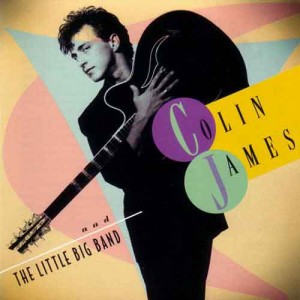 Colin James: Vocals, guitar
Colin James: Vocals, guitar
with
Johnny Ferreira: Tenor saxophone
Reese Wynans: Piano
Chuck Leavell: Keyboards
Norm Fisher: Bass
Rhode Island Boys Choir: Background vocals
and from Roomful Of Blues
Greg Piccolo: Tenor Saxophone
Rich Lataille: Alto saxophone
Bob Enos: Trumpet
John “The Fly” Rossi: Drums
Doug James: Baritone sax
Carl Querfurth: Trombone
1995
PORKY COHEN WITH ROOMFUL OF BLUES & SPECIAL GUESTS
Rhythm & Bones (Bullseye Blues Records CD BEYE-9572)
Produced by Carl Querfurth
Executive Producers: Bob Bell & Carl Querfurth
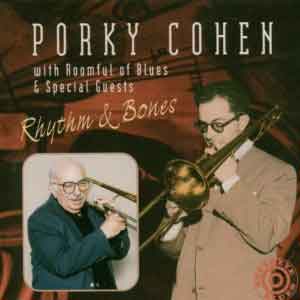 Porky Cohen: Trombone
Porky Cohen: Trombone
Matt McCabe: Piano
Sugar Ray Norcia: Vocals
Carl Querfurth: Trombone
John Rossi: Drums
Chris Vachon: Guitar
Marty Ballou: Bass
Bob Enos: Trumpet
Doug James: Baritone saxophone
Rich Lataille: Alto saxophone, tenor saxophone
with
Tom Reed: Bass
Michelle “Evil Gal” Wilson: Vocals
Rob Nelson: Guitar
Gordon “Sax” Beadle: Tenor saxophone
Ken “Doc” Grace: Bass
1997
STEVIE RAY VAUGHAN & DOUBLE TROUBLE
Live At Carnegie Hall (Epic Records EK-79163
Produced by Stevie Ray Vaughan
Executive Producer: Tony Martell
Stevie Ray Vaughan: Guitar, vocals
Chris Layton: Drums
Tommy Shannon: Bass guitar
with
Jimmie Vaughan: Guitar
Dr. John: Organ, piano
George Rains: Drums
Angela Strehli: Vocals
and from Roomful Of Blues
Bob Enos: Trumpet
Porky Cohen: Trombone
Rich Lataille: Alto sax
Greg Piccolo: Tenor sax
Doug James: Baritone sax
RECOMMENDED COMPILATIONS
There have been quite a few “best of” collections released over the years documenting the lengthy career of Roomful. Below are two which neatly divide their output into the early years and their middle period. Both are in-print and easily available at Amazon.com or other online outlets and are also available as downloads from iTunes and other servers. Roomful’s “modern” era has yet to be documented in a compilation.
1999
Swingin’ & Jumpin’: 1970s Recordings (32 Jazz Records CD 32146)
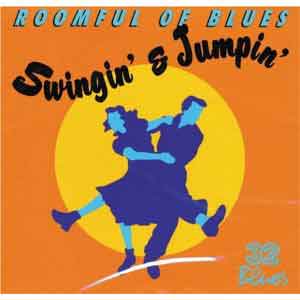 2000
2000
The Blues Will Make You Happy, Too: 1981-1998
(Rounder Records Heritage Series/Essential Recordings CD SELECT-611985)
ROOMFUL OF BLUES FILMOGRAPHY
1988
IT’S A COMPLEX WORLD
Roomful Of Blues appears in live performance during the film
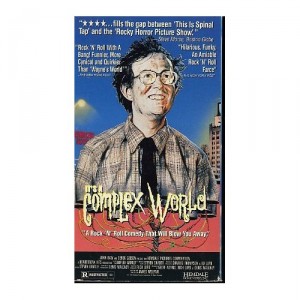 THE GOOD MOTHER
THE GOOD MOTHER
Roomful Of Blues makes an on-screen appearance and contributes three songs to the soundtrack
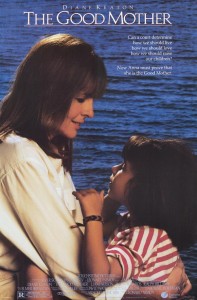 1999
1999
CODE OF ETHICS
Roomful Of Blues contributes several songs to the soundtrack/score
ROOMFUL OF BLUES LINKS & RESOURCES
DOUG JAMES ORAL HISTORY CONDUCTED BY RIMHOF ARCHIVE COMMITTEE MEMBER ALLEN OLSEN WITH DANA NEUGENT NOVEMBER 11, 2014
ROOMFUL OF BLUES OFFICIAL WEBSITE
www.roomful.com/
DUKE ROBILLARD OFFICIAL WEBSITE
www.dukerobillard.com/
RONNIE EARL & THE BROADCASTERS OFFICIAL WEBSITE
www.ronnieearl.com/
CARL QUERFURTH OFFICIAL WEBSITE
www.bluesbone.com
AL COPLEY OFFICIAL WEBSITE
www.alcopley.com/
GREG PICCOLO & HEAVY JUICE OFFICIAL WEBSITE
www.gregpiccolo.com/
KIM WILSON & THE FABULOUS THUNDERBIRDS OFFICIAL WEBSITE
www.fabulousthunderbirds.com/
PRESTON HUBBARD OFFICIAL WEBSITE
www.prestonhubbard.com/
CURTIS SALGADO OFFICIAL WEBSITE
www.curtissalgado.com/
RON LEVY’S WILD KINGDOM OFFICIAL WEBSITE
www.levtron.com/
SUGAR RAY NORCIA OFFICIAL WEBSITE
www.sugarrayandthebluetones.com/
THOM ENRIGHT OFFICIAL WEBSITE
www.thomenright.com/
PORKY COHEN BIOGRAPHY & OBITUARY AT TROMBONE U.S.A.
www.trombone-usa.com/cohen_porky.htm
JIMMIE VAUGHAN BAND FEATURING LOU ANN BARTON
www.jimmievaughan.com/
WIKIPEDIA ENTRY FOR ROOMFUL OF BLUES
http://en.wikipedia.org/wiki/Roomful_Of_Blues
WIKIPEDIA ENTRY FOR LOU ANN BARTON
http://en.wikipedia.org/wiki/Lou_Ann_Barton.
